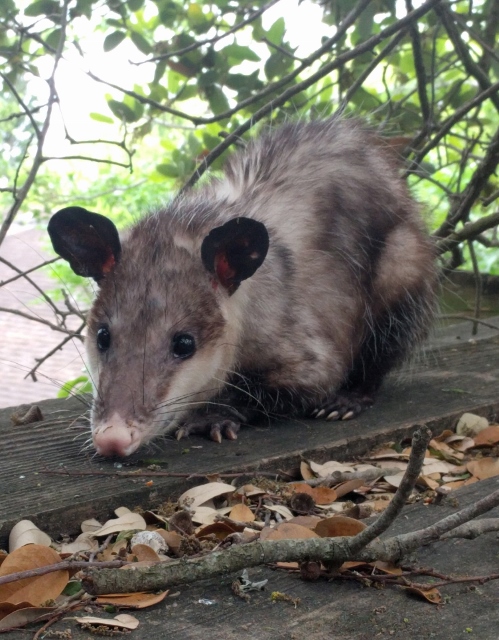by M. Kathy Raines

“C’mon, possum, you can do it!” I cheered, bundling the dog off to her kennel. Sure enough, within minutes, the possum had revived and climbed the fence, a perch from which it peered down at me. And this is the usual outcome. Remarkable creatures, these possums!
With its toothy, alligator-like face, the pervasive, oft-maligned Virginia opossum (Didelphis virginiana), or possum, prompts a schoolyard taunt: “Tu tienes cara de tlacuache!” (You have a possum face). Truth is, this coarse-furred mammal, North America’s sole marsupial, endears few of us as it stands its ground atop branch or fence top, hissing and drooling.
Were they prettier, and people, wiser, we might, if not embrace these fine creatures, at least refrain from killing them or carting them off to be relocated, a process, giving them a mere 50% chance of survival.
Not that the species faces any trouble. In fact, possums—generalists like raccoons and coyotes—adapt beautifully to our habits and have, in fact, spread northward—though, in doing so, possums sometimes lose the tips of their ears to frostbite.
These benign, housecat-sized creatures, though not cuddly, serve us well. A possum consumes an extraordinary number of insects, including mosquitoes that carry the Zika and West Nile viruses and dengue fever. Also, it eats ticks, which can carry Lyme disease or Rocky Mountain Spotted Fever. In fact, in one study, caged possums ate 96 percent of the ticks placed in their enclosures.
Possums, immune to the poison of most vipers, eat rattlesnakes. In fact, a protein in their blood neutralizes venom, offering promise as an antidote to snake bite. And, like vultures, possums dispose of roadkill—one reason possums become roadkill themselves.
Possums almost never carry rabies. Also, with its low body temperature, a possum is less likely than a raccoon or coyote to transfer diseases to people, livestock, or pets; however, one should take care not to become exposed to a possum’s feces or urine and wear a face mask if disposing of a possum or its wastes in a closed, poorly ventilated space.
Also, scientists, seeking to understand a human embryo’s response to the Zika virus and other traumas, study the development of possums, whose young arrive as jellybean-sized embryos.
Though rumored to attack chickens, a possum rarely does, as the meat portion of its omnivorous diet includes chiefly worms, insects, spiders, snakes and carrion. Also, a possum is unlikely to harm a beloved pet. Loath to go on the attack, a possum’s hissing, rumbling, growling and drooling serve merely as a hopeful bluff.
When threatened, a possum stays put for some time before crawling off. Once I tried to rescue a possum from a fence top while my dog lunged at it. Grabbing a branch, I tried to knock it into a neighbor’s yard. But the possum wouldn’t budge. And it survived the encounter.
A captured possum will indeed “play possum”. It freezes, foams at the mouth, urinates and releases a foul green liquid; it not only looks dead, but smells dead. Many predators spurn such prey.
Seemingly a true seizure, this state persists from a few minutes to hours. Awakening, the possum’s ears wiggle, as it determines whether a danger has passed. A continued threat sends it back to its coma.
Possums, largely solitary creatures, meet only to mate, and embryos—blind, bald and honeybee-sized—arrive in 11 or 12 days. They crawl to their mother’s pouch, attaching themselves to one of about 13 nipples; those exceeding this number will die. Her nipples swell, filling embryos’ mouths, firmly attaching them to her. At about seven weeks, they detach themselves, often riding on the mother’s back, returning to the pouch to suckle.
Like cats, possums regularly groom themselves. Sleeping most of the day, they forage for food at night. Excellent climbers, possums have a prehensile tail which they can use like an extra arm. Contradicting cartoon representations, they do not, unless posed, normally hang by their tails. Possums, like primates, have an opposable thumb.
Few value a possum’s long, coarse fur, though Texas designates it a furbearing animal. Some do swear that possum meat is delicious if properly cooked, and one can obtain a permit for hunting or trapping them. One may trap and kill a nuisance possum but may not keep the pelt.
Though some do so—and I’ve seen a woman walking a possum on a leash on the beach—one cannot legally adopt a possum, or any wild creature, as a pet, though Texas occasionally grants permission for research. One finding an obviously orphaned or injured possum can, rather, call a wildlife rehabilitator—here in the Valley, the Gladys Porter Zoo—or a vet who treats wild creatures.
Possums, which usually live only a few years, often die under the wheels of a car or in the jaws of dogs, coyotes, bobcats or hawks.
I gratefully share my yard, and my world, with spunky possums who, besides consuming ticks and other pests, are intriguingly unflappable. Unlikely to startle, they practically pose for photographs, even drawings, and they provide ample opportunities for backyard study.

